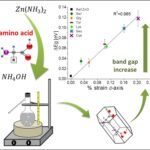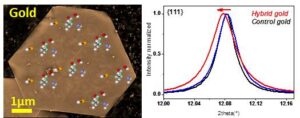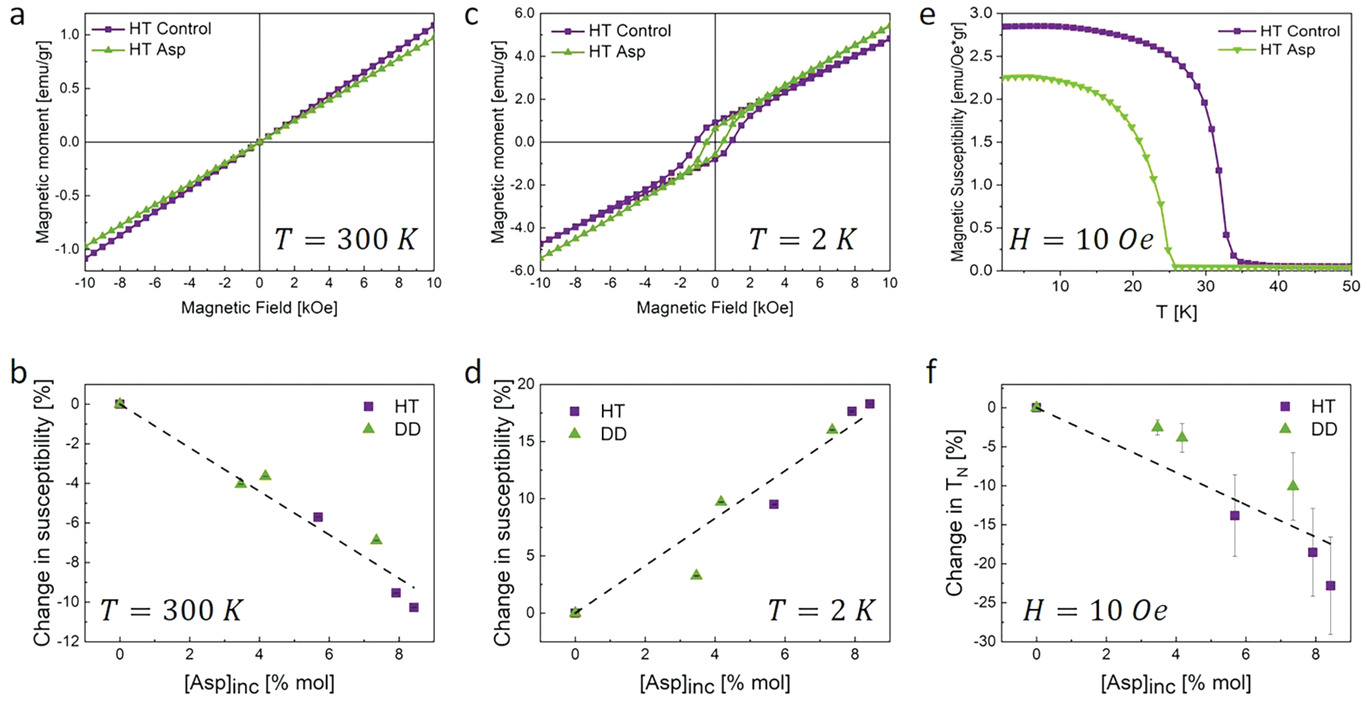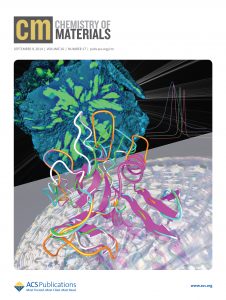One of nature's main strategies is growing crystals with improved mechanical and physical properties, usually CaCO3. This improvement (comparing to synthetic crystals), can be achieved by incorporation of organic molecules inside the inorganic crystals, which induce strains and cause cracks deflection. Inspired by nature, it was found that organic molecules, particularly amino acids and proteins, can be incorporated into the crystal lattice of synthetic calcite and induce anisotropic lattice distortions. Moreover, other functional materials such as semiconductors (ZnO and Cu2O) and hybrid perovskites also allow for such incorporation.

Figure 1. Synthesis of the ZnO-amino acids crystals and their band gap as a function of measured lattice strain along c-axis.
Similar to calcium carbonate system, such incorporation induces strains and causes the lattice parameters to change. In the case of ZnO and Cu2O, these strains also create a tunable change in the optical band-gap, which is directly dependent on the amount of molecules that were incorporated. We further showed that PbS crystalline host allows for the incorporation of various common amino acids. Such incorporation induces an increase in the lattice parameter of the PbS host, as well as changes in the PbS crystal morphology. The distribution of incorporated amino acids is not homogeneous, which results in the splitting of the HR-PXRD peaks and non-uniform crystal morphology. More importantly, we showed that the band gap of PbS excessively increases upon incorporation of AAs. The amino acids possessing large side chains, such as Phe and Lys, induce the biggest changes in the optical band gap (up to almost 40%), even though the induced lattice distortions are not the most pronounced, probably due to a lower incorporation level.
We also demonstrated and deciphered the mechanism of amino acids-induced band gap change and improved stability in the case of hybrid perovskite methylammonium lead bromide.
Moreover, we reported on the formation of hybrid organic-metal composites via the incorporation of selected amino acids into the crystal lattice of single crystals of gold, which is this the first finding of incorporation of organic molecules within the gold lattice.

Figure 2. left. Schematics of gold crystal with incorporated amino acids. Left. The {111} diffraction peak from Au-control and Au-Ala samples before and after heating. a) Au-control before (black) and after (red) annealing at 250ºC for 2 h.
We have shown for the first time that the incorporation of amino acids into the crystal lattice of manganese (II) carbonate induces significant changes in its magnetic susceptibility. This phenomenon depends on the magnetic ordering of manganese (II) carbonate. At room temperature, it is inherently paramagnetic and its susceptibility upon incorporation of amino acids decreases following the simple rule of mixture. At low temperatures, manganese (II) carbonate is a canted antiferromagnet, which exhibits weak ferromagnetism. Upon AA incorporation, it becomes more magnetically compliant owing to the weakening of the superexchange interaction induced by amino acids-incorporation-governed lattice expansion. Moreover, as a result of the AAs incorporation, the transformation temperature of these two magnetic states is decreased.

Changes in magnetic properties of MCO due to incorporation of Asp. a,b) Decrease in magnetic susceptibility measured at room temperature. c,d) Increase in magnetic susceptibility measured at 2 K. e,f) Decrease in TN measured during heating at zero magnetic field relative to the control sample. In (b,d), the error bars are smaller than the data points.
This study demonstrates the feasibility of tuning the magnetic properties of a crystalline host via a bioinspired route, namely incorporation of AAs. This method facilitates the use of small, organic biomolecules, which provide the control over the magnetic properties of the host, without the need of changing its chemical structure or stoichiometry. Given the tunability of magnetic properties demonstrated here is based on the change in interatomic distances, we strongly believe that this method can be applied to other magnetic crystals possessing superexchange interactions (among them are Fe3O4, CuO, and CrO2). Moreover, we believe that the concept described in this study can be expanded to incorporation of other organic and inorganic species (for example, monosaccharides and silica nanoparticles)
Moreover, we employed the same reductionist approach and studied how the mineral host is affected when grown in the presence of mono- or triphosphate nucleotides─the building blocks of nucleic acids. We show that the nucleotides facilitate the stabilization of the amorphous polymorph of CaCO3, as well as promote the formation of vaterite, its least thermodynamically stable anhydrous crystalline phase. We use high-resolution powder X-ray diffraction and a variety of chemical analysis tools to demonstrate the mechanism by which nucleotides become incorporated within the vaterite lattice.
Publications:
 Lang A, Polishchuk I, Katsman A and Pokroy B*. The Effect of Nucleotides on the Phase and Crystal Structure of Synthetic Calcium Carbonate. Cryst Growth Des, 2023; 23(7):5117.
Lang A, Polishchuk I, Katsman A and Pokroy B*. The Effect of Nucleotides on the Phase and Crystal Structure of Synthetic Calcium Carbonate. Cryst Growth Des, 2023; 23(7):5117.
Lang A, Polishchuk I, Confalonieri G, Dejoie C, Maniv A, Potashnikov D, Caspi E.N, Pokroy B*. Tuning the Magnetization of Manganese (II) Carbonate by Intracrystalline Amino Acids. Adv Mater, 2022, 34(34):2201652.
Lang, A, Brif A, Polishchuk I, Kurashvili M, Feldmann J and Pokroy B*. Excessive Increase in the Optical Band Gap of Near Infra-Red Semiconductor Lead (II) Sulfide via the Incorporation of Amino Acid. Adv Opt Mater 2022, 10(14):202200203.
Lang A, Mijowska S, Polishchuk I, Fermani S, Falini G, Katsman A, Marin F and Pokroy B*. Acidic monosaccharides become incorporated into calcite single crystals. Chem: Eur J 2020; 26:16860.
Lang A, Polishchuk I, Seknazi E, Feldmann J, Katsman A, Pokroy B. Bioinspired Molecular Bridging in a Hybrid Perovskite Leads to Enhanced Stability and Tunable Properties. Adv Funct Mater 2020; DOI: 10.1002/adfm.202005136.
Polishchuk I, Bianco-Stein N, Lang A, Kurashvili M, Caspary Toroker M, Katsman A, Feldmann J and Pokroy B. Strong Band Gap Blueshift in Copper (I) Oxide Semiconductor via Bio-Inspired Route. Adv Funct Mater 2020; 30(13):1910405.
Mijowska S, Polishchuk I, Lang A, Seknazi E, Dejoie C, Fermani S, Falini G, Demitri N, Polentarutti M, Katsman A and Pokroy B. High amino acid lattice loading at non-ambient conditions causes changes in structure and expansion coefficient of calcite. Chem Mater 2020; 32(10):4205.
Brif, A, Ankonina, G, Drathen, C, & Pokroy, B. Bio‐Inspired Band Gap Engineering of Zinc Oxide by Intracrystalline Incorporation of Amino Acids. Adv Mater 2014, 26(3), 477-481.
Weber E, Bloch L, Guth C, Fitch AN, Weiss IM and Pokroy B. Recombinant biomineralization fusion protein induces anisotropic lattice distortions in synthetic calcite. Chem Mat 2014; 26:4925. HIGHLIGHTED ON THE COVER.
Chen, L, Polishchuk, I, Weber, E, Fitch, A. N, & Pokroy, B. Hybrid gold single crystals incorporating amino acids. Crys Grow & Des 2016; 16(5), 2972-2978.
Borukhin S, Bloch L, Radlauer T, Hill AH, Fitch AN, Pokroy B. Screening the Incorporation of Amino Acids into an Inorganic Crystalline Host: the Case of Calcite. Adv Funct Mater 2012; 22:4216.

